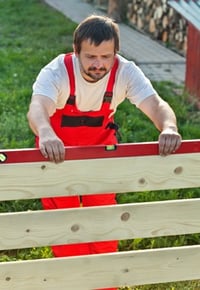
A fence is much more than just a structure that divides two areas of land. Fencing can solve many problems for land or homeowners such as providing containment for livestock, increasing curb appeal, or offering safety and security. And regardless of the materials used, the most popular options being wire, aluminum, chain link, vinyl, wood and wrought iron, there are some do’s and don’ts when installing a fence to keep in mind.
Contractors should be on autopilot for the first two steps, but for do-it-yourselfers, it’s important to remember to check local ordinances for any guidelines that may apply to your fence before beginning construction, including your Homeowner’s Association. And remember to call and have all buried utility lines located and marked before digging.
Despite the varying options in style, materials and uses for a fence, there are some tips from a helpful article that could aid any installer to help make a fence installation even more successful.
The Do’s
- Do double check to make sure you have received all parts and materials before beginning construction.
- Do make sure the concrete, for corners and ends, is completely set before tightening the monofilament line or hanging the fence mesh.
- Do use a level as this will ensure perfectly plumb posts.
- Do mound the dirt around your posts slightly to prevent pooling of water.
- Do add gravel or crushed stone to the bottom of your postholes. This gives posts a solid base but is unnecessary when installing in areas of heavy clay and rock.
- Do plan your gate placement before beginning construction to avoid issues with post and brace placement.
- Do dry fit all parts before drilling or installing.
- Do install your post extensions and post caps before installing the posts.
- Do use at least one zip tie every foot along your line posts.
- Do stake your fence to the ground every 5 feet. Deer will always try to go under a fence before over it.
- Do use a product such as the BECK® Fence Stapling System which includes air-driven fence stapling which boasts holding power and superior corrosion protection making these staples a reliable long term fence fastening solution.
The Don’ts
- Don’t install the fence without first checking your property lines carefully.
- Don’t eye ball post placement. Measure carefully for evenly spaced fence posts, making sure to mark all post placements in a line before digging.
- Don’t skip corner bracing. Corner posts carry the weight of your fence stretched in two directions so this means bracing should be added in each direction for a more secure fence.
- Don’t just dump soil in around line posts and tamp down with your foot. Add soil in increments of 6 inches and firmly tamp with a wood post or tamping device before adding the next 6 inches.
- Don’t skimp on the depth of your postholes. Corner posts should sit a few inches below the frost line to prevent posts from heaving. This means in most areas your post should be dug to a depth of 30-36”.
- Don’t install your line posts before the monofilament. Installing the monofilament line first gives you a perfect guideline for placing your posts.
- Don’t forget the post caps. Without the post caps your posts could fill with water and deteriorate faster.
- Don’t weave the monofilament line through the fence. This will cause bunching and create a wavy finished look. Use hog rings or zip ties instead.
The BECK® Fence Stapling System is the perfect balance of superior holding strength and superior corrosion resistance. And with the added benefit of using a pneumatic stapler for ease and speed, you can ensure that your large wire fencing jobs are done with both the quality you need and the efficiency you require. Watch the video to see for yourself.
.svg.png)

